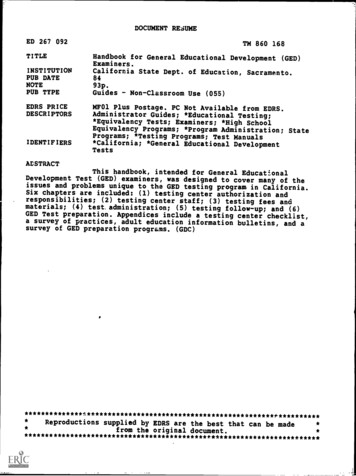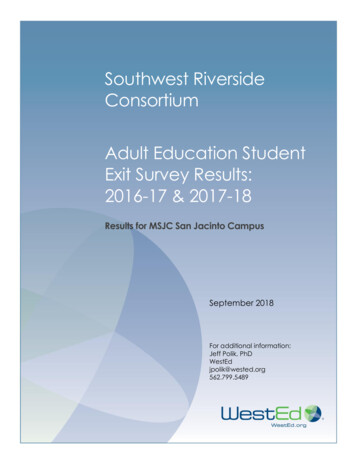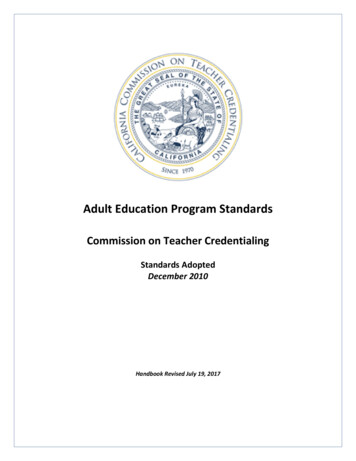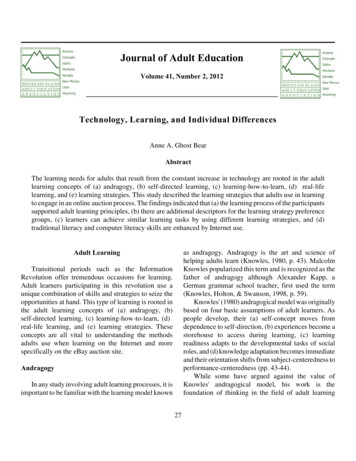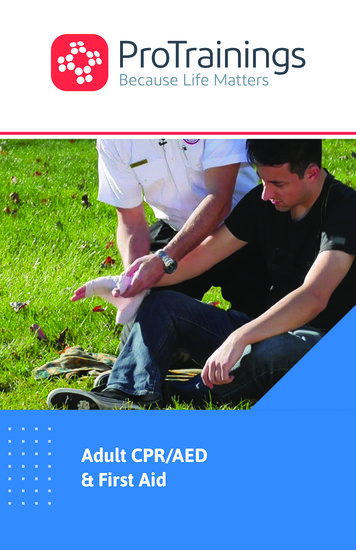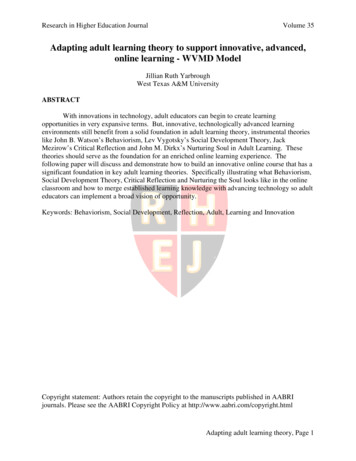
Transcription
Research in Higher Education JournalVolume 35Adapting adult learning theory to support innovative, advanced,online learning - WVMD ModelJillian Ruth YarbroughWest Texas A&M UniversityABSTRACTWith innovations in technology, adult educators can begin to create learningopportunities in very expansive terms. But, innovative, technologically advanced learningenvironments still benefit from a solid foundation in adult learning theory, instrumental theorieslike John B. Watson’s Behaviorism, Lev Vygotsky’s Social Development Theory, JackMezirow’s Critical Reflection and John M. Dirkx’s Nurturing Soul in Adult Learning. Thesetheories should serve as the foundation for an enriched online learning experience. Thefollowing paper will discuss and demonstrate how to build an innovative online course that has asignificant foundation in key adult learning theories. Specifically illustrating what Behaviorism,Social Development Theory, Critical Reflection and Nurturing the Soul looks like in the onlineclassroom and how to merge established learning knowledge with advancing technology so adulteducators can implement a broad vision of opportunity.Keywords: Behaviorism, Social Development, Reflection, Adult, Learning and InnovationCopyright statement: Authors retain the copyright to the manuscripts published in AABRIjournals. Please see the AABRI Copyright Policy at http://www.aabri.com/copyright.htmlAdapting adult learning theory, Page 1
Research in Higher Education JournalVolume 35INTRODUCTION“Tell me and I forget. Teach me and I remember. Involve me and I learn.” – Benjamin FranklinMr. Franklin’s famous quote is meaningful because it clearly defines a critical componentof effective learning. Mr. Franklin identifies that telling and directing are the simplest methodsof instruction whereas involvement of the learner in the learning process, results in thedevelopment of new information and new skills for the protege. So, Mr. Franklin’s quote isdescribing the instructional deference’s between basic learning experiences and advancedlearning experiences. At a basic level, learning in some ways is an instinct, somethingpossessed by all individuals, to seek meaning and understanding in their everyday lives. Haveyou ever watched a newly mobile baby, their curiosity is endless as they explore theirenvironment? Likewise, a toddler that is develop language, from the beginning the newly vocaltoddler seeks to know “why” to everything. Certainly, for most of us, the curiosity and questionscontinue as we grow, and our minds are constantly engaged in ideas, fact finding, assessment ofexperiences and gathering of information. And, as we reach adulthood learning is no lessdynamic or engaging, rather equally valuable and it is important to note, effective adult learningis guided by unique learning principles. While child learners are often involved in pedagogicalteaching philosophies like instructor driven learning environments, instructor directed learningexperiences and instructor facilitated assessment, adult learners benefit from the opportunity todirect much of their own learning, from selecting learning topics to self-assessments. Therecognition of unique adult learning principles was introduced into the research literature when,in 1968, Malcolm Knowles, distinguished professor of adult education introduced the termAndragogy. Specifically, Knowles identifies that adult learners are different from childrenlearners and adults value self-directed learning, have a vast reservoir of experiences as their ownpersonal learning resource, seek problem solving through learning, want to learn about topicsrelevant to their lives and they possess internal motivation (Knowles, 1990). Succinctly, adultslook for ways of understanding experiences in real time, pursuing attainment of skills that canhelp them navigate the challenges of their life (Goffman, 1959).Adult learners, sometimes referred to as non-traditional university students, have somecommon characteristics like they often have full time employment, dependents and are generally25 years or older. And, individuals with these characterizes, the non-traditional adult learners,are a growing presence on college campuses and now represent a significant percentage of theundergraduate student population (Ross-Gordon, 2011). Consider, from 2000 to 2012enrollment of students over the age of 25 increased by 35% (NCES, 2016) and it is projected thatby 2019, the number of students over age 25 will increase by another 23% (Hess, 2011).Universities are responding to the increasing non-traditional student enrollment with theexpansion of distance learning options. In 2016, it was reported that the number of, “onlinecourses grew to 5.8 million nationally, continually a growth trend that has been consistent for 13years,” (OLC, 2016). So, there are more and more adult learners attending the university andone of their preferred learning methods is the online classroom, as reflected in the increasingnumbers of online course offered across the country. With increased course offering eachsemester, it is important to create checks and balances to verify the quality of the online learningexperience. One way to ensure quality learning is to maintain an online educational experiencewith a foundation in adult learning theory. But, do traditional adult learning theories translateeasily to the online classroom? And how do we align the understood underlying principles ofAdapting adult learning theory, Page 2
Research in Higher Education JournalVolume 35adult learning with the online learning environment? The following paper will examine John B.Watson’s Behaviorism, Lev Vygotsky’s Social Development Theory, Jack Mezirow’s CriticalReflection and John M. Dirkx’s Nurturing Soul in Adult Learning and specifically how thesetheories should serve as the foundation for an innovative and advanced online learningexperience.BRIEF DESCRIPTION OF THE THEORIESJohn B. Watson’s BehaviorismJohn B. Watson (1878-1958) was an American born psychologist recognized forestablishing the psychological school of Behaviorism. The Yale University archives containsletter correspondence between early behaviorist John B. Watson and Robert M. Yerkes, anotherdistinguished American Psychologist, most noted for his work on comparative psychology andintelligence testing. The two exchanged letters regarding Watson’s development ofBehaviorism in which Watson says in a letter:I came up through philosophy into introspective psychology, ran the laboratory atChicagofor years, doing both my animal work and looking after the problems and teachingstraight introspective psychology. I had to put away all outside thought and fight to makeintrospectivepsychology scientific, and 1 have had many rows and arguments with biologists andotherstrying to make my points. The first few years at Hopkins I had to do the same thing,running both the human laboratory and the animal. Finally, my stomach would stand nomore and I tookthe plunge I did in 1912.- John Broadus Watson, in a letter to Robert Yerkes (Plaud,1991).And in 1913, Watson promoted this change in psychology through lectures given atColumbia University. In his lectures, Watson said, "The time seems to have come, whenpsychology must discard all reference, to consciousness." And as time passed, John B. Watsonbecame something of a 1920s “celebrity” psychologist, publishing a series of self-help manualspromoting behavioral engineering as a potential foundation for personal peace and social order(Reed, 1989).Watson wanted a complete break or thorough separation between psychology andmentalism and philosophical concerns. With his pursuits, the behaviorist began to gain supportand in 1913, Watson published the article entitle Psychology as the Behaviorist Views It. Thisarticle establishes the underlying assumptions regarding Behaviorism.1. All behavior is learned from the surroundings.2. Psychology should be a science with theories supported by experimentation throughcontrolled observation.3. Behaviorism is primarily concerned with observable behavior. Internal events likethinking and emotion should be discounted.4. There is a little difference in the learning that occurs in humans and other animals.Adapting adult learning theory, Page 3
Research in Higher Education JournalVolume 355. All behavior, no matter how simple or complex, can be reduced to a simple stimulusresponse learner association.Applications in Adult EducationIn summary, Behaviorism is a learning theory supporting the idea that behavior can becontrolled or modified based on the preceding or following reactions to behavior. So, in thelearning experience a behavior will occur if given the right environment and a behavior is onlylikely to reoccur based on the consequences that follow, either reward or punishment. Anadvantage of Behaviorism is the ability to clearly define the intended behavior and then create anenvironment that will measure the behavior, support the behavior and foster reoccurrence.Behaviorism is, from a scientific standpoint, looking for simple explanations of human behavior.As an example, consider an online algebra class. First, the instructor creates a video andposts the video in the online classroom showing the learner how to solve an algebra problem,then the problem will be assigned to the student. The student is asked to create a video of theprocess they use to solve the problem. The student is told if they solve the problem, they willreceive an immediate electronic medal. With ten electronic medals, they will receive extra creditin the course. This is a new algebra problem to the student. None of their previous learning hasprepared them to complete the problem. What will they do? This depends on their previousexperiences with math. The student will apply their previous math strategies to solving thisequation. Suppose the student has 10 attempts, learned and unlearned responses and through thisprocess the student solves the math problem. The time it took the student to solve the problemwas 15 minutes. Once solved, the student receives an electronic medal. The next time thestudent is given the problem, they make fewer mistakes and solve in 5 minutes. In three trials orless the student will be able to solve the type of problem rapidly. The student’s ability tocomplete the problem with increased speed is a function of frequency and regency (Watson,1930, p. 204). In the online classroom, assignments should be structured such that desiredstudent behaviors can be defined and are directly scaffolded by the assigned work. The student’sdevelopmental behavior and growth should be observable and desired student performanceshould be rewarded.Lev Vygotsky’s Social Development TheoryLev Vygotsky (1896-1934) was a Russian born Psychologist who gained global attentionwith his 1962 publication of his Social Development Theory, one of the foundations forconstructivism. Vygotsky’s Social Development Theory (SDT) introduces two major principles:1. Cognitive development is limited up to a certain extent or within a certain range, at anygiven age of the individual.2. An individual’s full cognitive development requires social interaction.Three themes support Vygotsky’s SDT principles: Social Interactions, The More KnowledgeableOther (MKO), and the Zone of Proximal Development (ZPD).Social InteractionAccording to Vygotsky, cognitive, conscious intellectual activity, is a result of reciprocalinteraction exchanges between individuals and society. Just as society is shaping the individual,Adapting adult learning theory, Page 4
Research in Higher Education JournalVolume 35the individual is shaping society. Beginning as children we cannot learn without someinteraction with things or people. Rather through exploration, communications and observationswith others we gradually grow and develop. And social interactions continue to play afundamental role in our cognitive development as we age. Vygotsky believes development ispreceded by social development, stating: “Every function in the child’s cultural developmentappears twice: first, on the social level, and later, on the individual level; first, between people(inter-psychological) and then inside the child (intra-psychological)” (Vygotsky, 1978). Tosummarize, social exchange is required for learning and social interaction is necessary tofunction and become fully developed.More Knowledgeable Other (MKO)When we have something new to learn, we often seek a knowledge expert to help us gainnew information and apply new skills, we are seeking a mentor or as Vygotsky would say, aMore Knowledgeable Other (MKO). The MKO is any individual that has greater understandingor a higher skill level than the learner, with respect to a concepts, process or task. While theMKO can be a peer, a younger person or even technology, most often the MKO is a teacher,coach or older adult. Although, self-initiated learning and discovery can be effective, learningwill become increasingly productive and contribute to cognitive development when supported bya more knowledgeable other.The Zone of Proximal DevelopmentThe MKO works in conjunctions with Vygotsky’s Zone of Proximal Development(ZPD). The ZPD is something of a gap analysis, where the learning facilitator identifies thelearner’s ability to perform a task independent and at what point the learner will require MKOsupport and guidance to complete a task. Vygotsky claims it is the space between independenceand requiring guidance, the ZPD, that learning occurs.As a visual for the ZPD, consider an inner circle that represents what a learner alreadyknows and the outer most circle that represents what the learner does not know. The middlecircle represents what the learner can achieve or discover on their own. The inner circle, the gap,between independence and full support is where learning occurs. Within this zone, the learner ismost responsive to instruction and coaching from the MKO. The MKO should provideguidance and allow the learner to develop their own skills, by fostering independence the MKOwill help the learner gain higher mental functions faster.Adapting adult learning theory, Page 5
Research in Higher Education JournalVolume 35Figure 1: Vygotsky’s Zone of Proximal DevelopmentThe things the learnercannot do.Zone of Proximal DevelopmentThings the learner can do withhelp.Things the learner can do on his orher own.Applications in Adult EducationThe Social Development Theory (SDT) supports active learning, directed by students,facilitated by teachers where learners are encouraged to construct their own meaning. With theSDT, learning becomes an interactive and dynamic process for the instructor and the student. Asan example, consider an online management student that emails the instructor saying they do notunderstand the weekly content discussing Elton Mayo’s 1924 Study at the Hawthorne Plant.Instead of directly defining and restating Mayo’s Theory, the instructor sends back a series ofpictures that show a motivational work environment and then the instructor askes the student torecall a positive working experience and if their manager was highly communicative or rarelycommunicative. From the pictures and the reflection on their own experiences, the student willbegin to understand Elton Mayo’s Hawthorne Effect and Mayo’s conclusion that employees needattention, recognition and support to be productive and satisfied at work.Jack Mezirow’s Critical ReflectionJack Mezirow (1923-2014) developed the Transformative Learning Theory (TLT),explained as “constructivist, an orientation which holds that the way learners interpret andreinterpret their sense experience is, central to making meaning and hence learning” (Mezirow,1994, p. 222). At its core, Transformational Learning is a developmental process that requiressignificant learner engagement. Mezirow describes the Transformational Learning process inthis way, “learning is understood as the process of using a prior interpretation to construe a newor revised interpretation of the meaning of one’s experience in order to guide future action”(Mezirow 1996, p. 162).The theory recognizes two types of learning: communication and instrumental learning.Communication learning describes how individuals, “communicate concerning values, ideals,feelings, moral decisions, and such concepts as freedom, justice, love, labor, autonomy,commitment and democracy” (Mezirow 1991, p. 8). Instrumental learning focuses on cause andeffect relationships through task-oriented problem solving.In addition to the two types of learning in TLT, the learning is examined further throughsub-categories of leaning perspectives, schemes and structures. Meaning perspectives are a“broad sets of predispositions resulting from psycho-cultural assumptions which determine theAdapting adult learning theory, Page 6
Research in Higher Education JournalVolume 35horizons of our expectations” (Mezirow, 1994, p. 223), while meaning schemes, are “made up ofspecific knowledge, beliefs, value judgments, and feelings that constitute interpretations ofexperience” (Mezirow 1991, pp. 5-6). And finally, meaning structures are develop fromreflection, specifically, “reflection involves a critique of assumptions to determine whether thebelief, often acquired through cultural assimilation in childhood, remains functional for us asadults” (Mezirow, 1994, p. 223). In other words, reflection is essential for learning and throughreflection we begin to understand ourselves more and as we understand ourselves we canorganize and learn new information. Ultimately, Mezirow’s Theory is an examination ofpeople, their worldviews and what leads people to change their view of the world (Christie,Carey, Robertson & Grainger, 2015).Finally, to support Transformative Learning, the learning environment must: Offer opportunities for critical thinking. Critical thinking can be fostered by providingcontent that introduces new ideas through journaling, critical assessment of personalviews or discussion with classmates. Offer opportunities for the learners to interact with other learners simultaneously engagedin the same transformative experience. Support a community of learning as transformation often occurs in community wherelearners are engaged in the exchange of ideas. Provide opportunities for the learner to apply their new perspectives.o To complete a transformative learning experience, students generally require afinal step of actively acknowledging their new belief.Applications in Adult EducationTransformational learning utilizes “disorienting dilemmas” to challenge learning’thinking, followed by critical thinking and introspective questioning regarding their underlyingbeliefs and assumptions about the world. “To facilitate transformative learning, educators musthelp learners become aware and critical of their own and others’ assumptions. Learners needpractice in recognizing frames of reference and using their imaginations to redefine problemsfrom a different perspective. Finally, learners need to be assessed to participate effective indiscourse,” (Mezirow, 1997, p. 7).Consider a business student taking a college course in Ethics and Sustainability. Prior tobeginning the course, the student believes a business cannot be profitable and charitable at thesame time. She is certain of this belief because her family has owned and operated a business formany years. Her family business requires a very lean budget and at this time could not makepayroll and give additional funds to charity. As a semester long assignment, in the Ethics andSustainability Course, this student with her classmates, will examine the relationship betweensustainability, profitability and philanthropy. The assignment will begin by asking students toresearch one company that is based in philanthropic actions like Tom’s Shoes. Their researchregarding the philanthropic organization’s actions and profits will serve as preparation for thesecond half of the assignment, an interview with a CEO from a local business regarding theirviews on philanthropic organizational activity. Students will be placed in teams and asked toshare their project progress throughout the semester. Finally, the instructor will share specificfeedback from industry experts like the following: “When you support your community your business is healthier,” (Neves, 2010).Adapting adult learning theory, Page 7
Research in Higher Education JournalVolume 35“A 2010 Hope Consulting study of wealthy investors found over 120 billion in potentialinvestments in mission-driven companies, the likes of which are candidates for benefitingcorporation status,” (MetroFocus, 2011). “As long as a brand chooses a social cause that fits their demographic, such as Yoplaitsupporting breast cancer research, the brand can utilize the cause in order to increaseprofits and make the company look better,” (Thompson, 2012). “Companies use charitable giving programs to improve their competitive position, whichenhances financial performance,” (Tonello, 2011).Through the student’s initial research, class discussion, local interviews and instructoroffered expert perspectives, the student’s understanding of the role of organization, philanthropyand profit will likely shift. The instructor and classmates will facilitate discussions regardinghow the newly obtained information may contrast with previous personal experiences. Thestudent will be asked to reflect on and consider these contrasts. Upon completing the semesterproject students will be asked to write their own summary statement defining a corporation’s roleregarding profit and philanthropy. The summary statements will be discussed in small onlinegroups with classmates and the final step will be to present personalized final conclusions withthe class. Overall, the goal of transformation learning is a “paradigm shift” in the learner’sunderstanding of the world around them that directly impacts their future actions. John M. Dirkx’s Nurturing the Soul in Adult LearningOctober 6 through 9, 2005, Michigan State University, held the Sixth InternationalTransformative Learning Conference and in a full conference meeting, Jack Mezirow and JohnDirkx discussed where their theories integrate in the session, “Whole Group Learning:Integration of Theories.” During which, the two theorists examined variations and consistenciesbetween their perspective of transformative learning. Mezirow’s transformational learningprocess is rational and based on the learner’s frame of reference, “Here is how I see the processof transformative learning. This rational process of learning within awareness is a metacognitiveapplication of critical thinking that transforms an acquired frame of reference—a mind-set orworldview of orienting assumptions and expectations involving values, beliefs, and concepts—by assessing its epistemic assumptions,” (Dirkx and Mezirow, 2006). In contrast, John Dirkx’stransformation learning view is subjective, rooted in the learner’s sense of identify and how theindividual sees their soul (Dirkz and Mezirow, 2006). Dirkz says, “The perspective on adultlearning from which I have been working for the past 20 years reflects a focus on the nature ofthe self, the various ways we have come to think about and understand our senses of self, oursenses of identify, our subjectivity,” (Dirkx and Mezirow, 2006). “I have come to refer to thisview of transformative learning as soul work or inner work,” (Dirkx, 1997).John M. Dirkx, current Professor and Mildred B. Erickson Distinguished Chair(Emeritus) in Higher, Adult and Lifelong Education at Michigan State University has madesignificant contributions to research regarding the emotional and spiritual dimensions oftransformative learning. Through his research, Dirkx has expanded upon the emotionaldynamics that develop within adult engaged in learning and ultimately Dirkx seeks clarityregarding how educators can support the emotional dynamics of the learning process in ameaningful way. Dirkx, says of his work with adults, learning and emotions, “I have come torefer to this view of transformative learning as soul work or inner work (Dirkx, 1997).Adapting adult learning theory, Page 8
Research in Higher Education JournalVolume 35Many researchers support or agree with Dirkx that emotions are a part of the learningprocess and part of our everyday experiences (Callahan, 2002; Dirkx, 2006; Perry, 2006; Reeve,2001; Wolfe, 2006). “Emotions are important in adult learning because they can either impedeor motivate learning” (Dirkx, 2001, p. 63). People that are experiencing anxiety, discomfort orfear may be unable to learn (Perry, 2006). Emotions can be motivators, create purpose and shapelearning context (Merriam & Caffarella, 1999). Emotions can alter our thought patterns andimpact the experience of learning (Opengart, 2005). Emotion plays a critical role in theconstruction of meaning and knowledge of the self in the adult learning process (Dirkx, 2001).“Through the experience of emotions, [we] come to recognize what is cognitively and affectivelyof value,” helping determine how and why we respond to the world around us (Dirkx, 2006, p.31). Finally, emotional, response to internal and external stimuli, is part of the humanexperience and as learning occurs within the human it is impossible to separate emotion from thelearning environment (Brookfield, 2006; Lehman, 2006).Applications in Adult Education“Those engaged in online learning deal with the effects of emotion on a daily basis,whether in designing instruction, teaching, or learning online,” (Cleveland-Innes and Campbell,2012). Educators can use the power of emotion to affect learning (Wolfe, 2006). One-wayeducators can use the power of emotions to affect learning is to support learning communities inthe online classroom. Many researchers have identified the value of learner driven communityas support system in the online classroom (Shakelford and Maxwell, 2012) (Shea, 2006)(Rovai,2002). Shakelford and Maxwell (2012), published a study, “Sense of Community in GraduateOnline Education: Contribution of Learner to Learner Interactions,” examining which type ofinteractions are most predictive of students’ sense of community in an online classroom. Theresearchers identified exchanges between learners like introductions, collaborative groupprojects, contributing personal experiences, entire class online discussions and exchangingresources as contributing the most to learner’s sense of community.Rovai (2002) is agreement with Shakelford and Maxwell that a sense of community canfoster emotions in the online learner, specifically she reports an online learning community canminizine online student’s feelings of disconnect, distraction, isolation or lack of personalattention which can affect a learner’s persistence and ability to learn in an online environment.Rovai, elaborates that a classroom community can be defined in four dimensions: trust, spirit,interaction and commonality of expectations of goals. The online learner will be managing allkinds of emotions from self-awareness to trust and the instructor will be building or destroyingemotions with consistent behaviors or encouragement or absence, disconnect or chastising. Insummary, “As an instructor, it’s crucial that you set up the learning situation in a manner thatarouses learners’ feelings of security, well-being, and self-confidence. It’s equally important tochallenge them without threats, intimidation, or pressure” (Weiss, 2000, p. 3).There are at least two ways to build or create an online classroom that is supportingpositive emotions like team, trust, development and spirit and minimizes emotions likedisconnect, isolation and distraction. The first, is for the instructor to lead with consistency,openness, willingness to dialogue, encouraging comments, supporting teams and collectivedecision making. Consistent, open, dialogue will help students gain comfort, security and trustin the online learning community. Second, the instructor must create a course where there areopportunities for the students to experience introductions, collaborate, contribute personalAdapting adult learning theory, Page 9
Research in Higher Education JournalVolume 35experiences and exchange resources. This can occur with discussion threads, group wikis, groupblogs and team resource summaries. With these assignments, rooted in a classroom ofcommunication, consistency and openness, the instructor is striving to facilitate positiveemotions that support a healthy learning environment.HOW ARE THE THEORIES USED TO SUPPORT INNOVATIVE, ADVANCEDONLINE LEARNING? To summarize the theories:Watson seeks to measure changes in behavior to acknowledge learning.Vygotsky believes learners should be engaged and active in their learning experiences,where they have social interaction and the MKO is scaffolding learning not directinglearning.Mezirow encourages reflection in which learner’s review experiences and theirinterpretations of the experiences, with this information they create meaning which canlead to changes in behavior.Dirkx supports expression of emotion within the learning experiences. When emotionsare included with learning, there is potential for the learn to experiences deepinvolvement in the construct of new meaning and new knowledge.The online classroom is often set up to offer content for which the learner is, in manyways, independently responsible for reviewing, understanding and applying. Assignments suchas readings, papers and tests usually are solo learner functions and completed in greater isolationfor the online learner.The author proposes applying Watson, Vygotsky, Mezirow and Dirkx to the standardonline classroom as “check list” for course development, projects or assignment alignment withadult learning theory. An online classroom with a foundation in Watson, Vygotsky, Mezirowand Dirkx would be a classroom where the instructor and the learner/l
Research in Higher Education Journal Volume 35 Adapting adult learning theory, Page 1 Adapting adult learning theory to support innovative, advanced, online learning - WVMD Model Jillian Ruth Yarbrough West Texas A&M University ABSTRACT With innovations in technology, adult educators can begin to create learning
